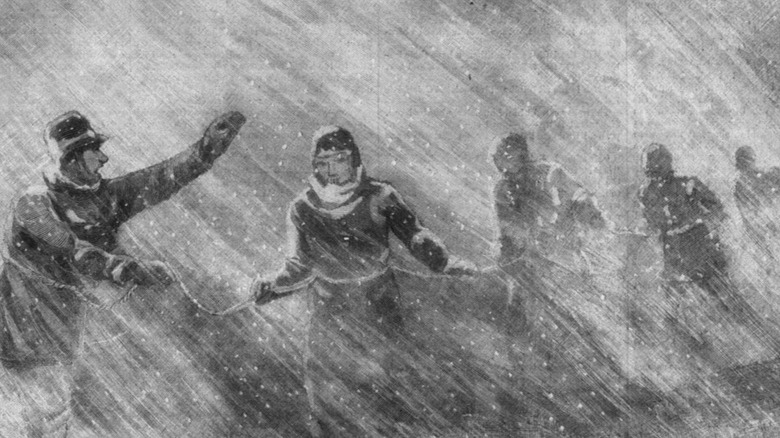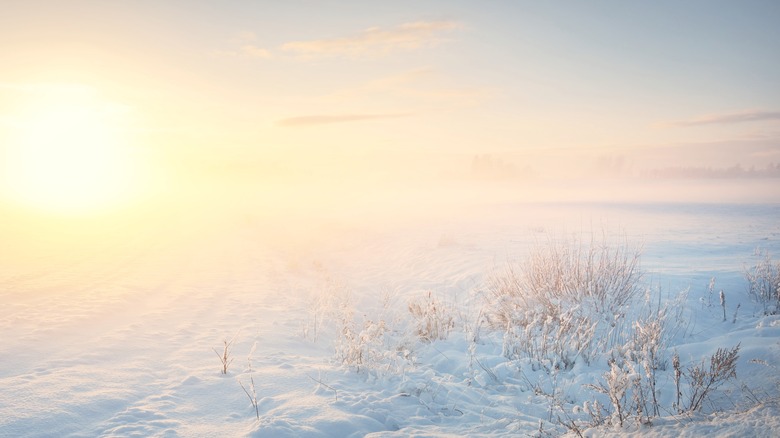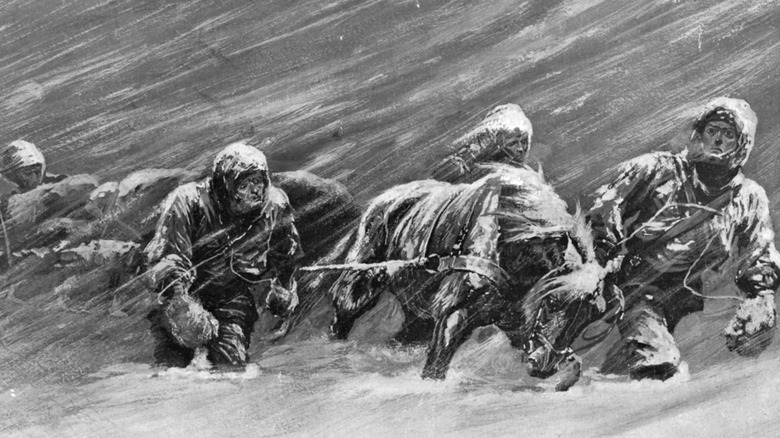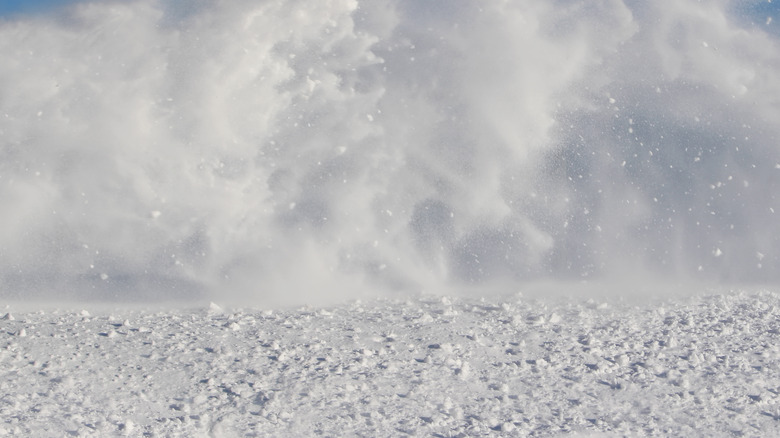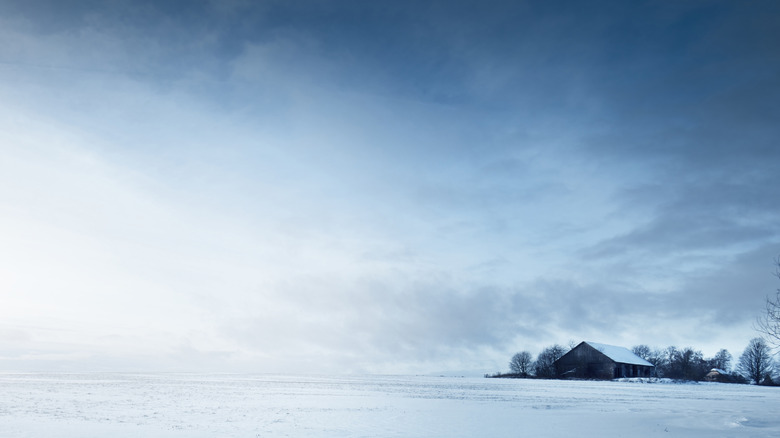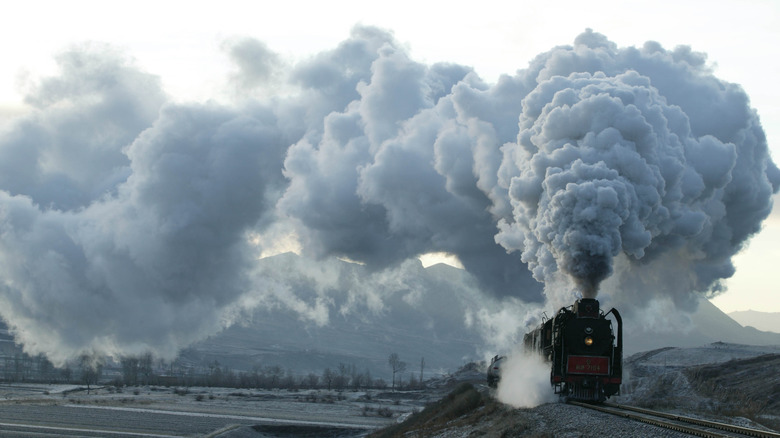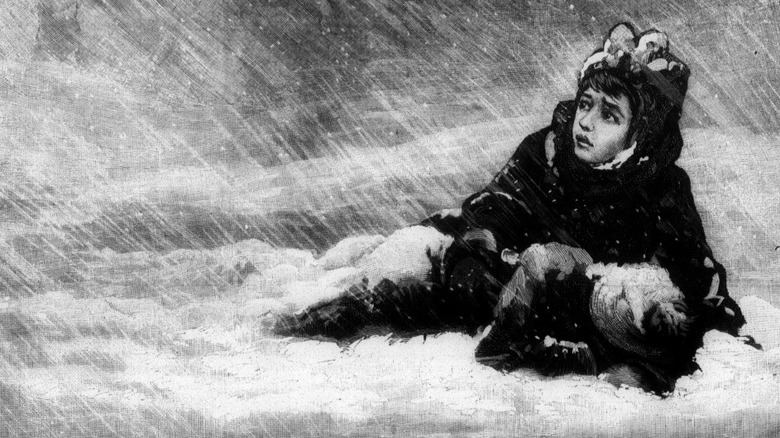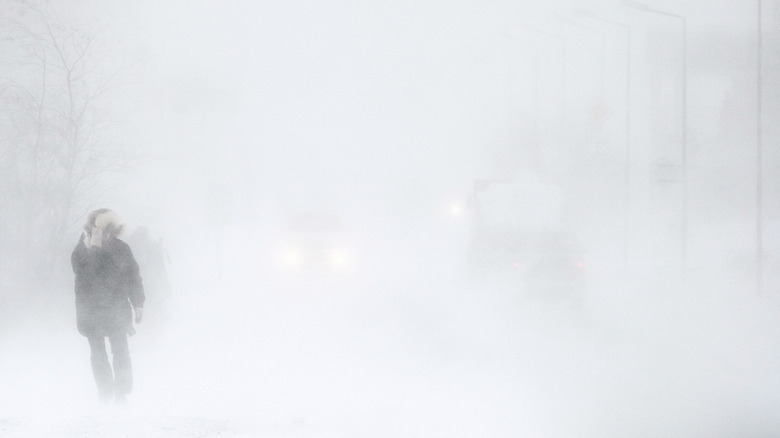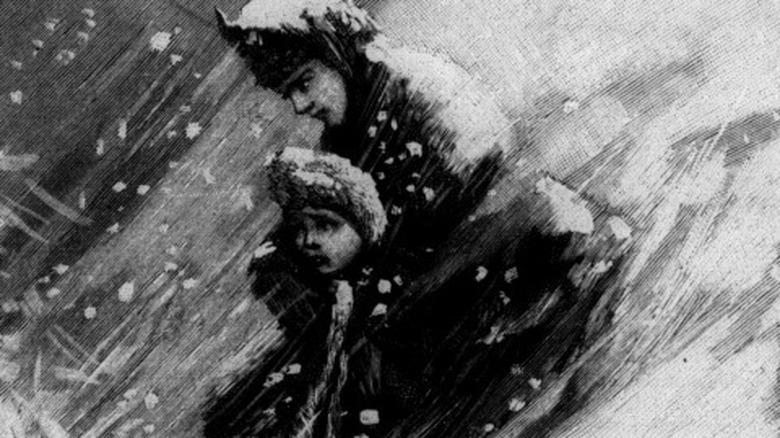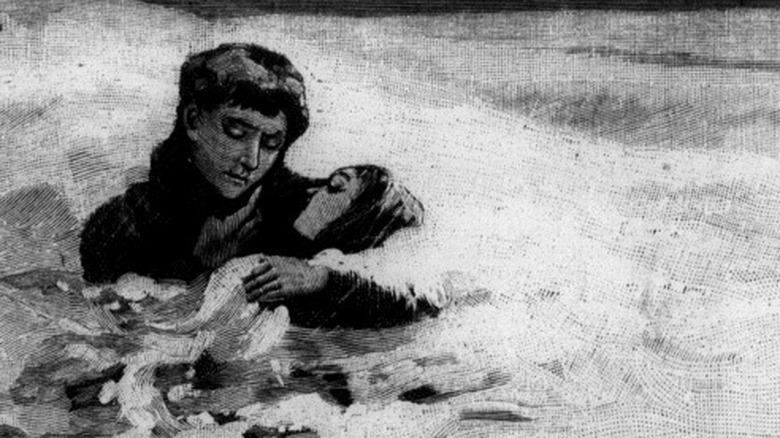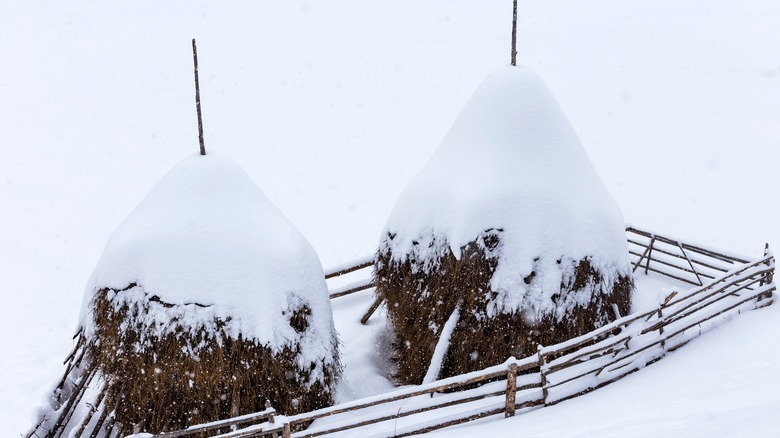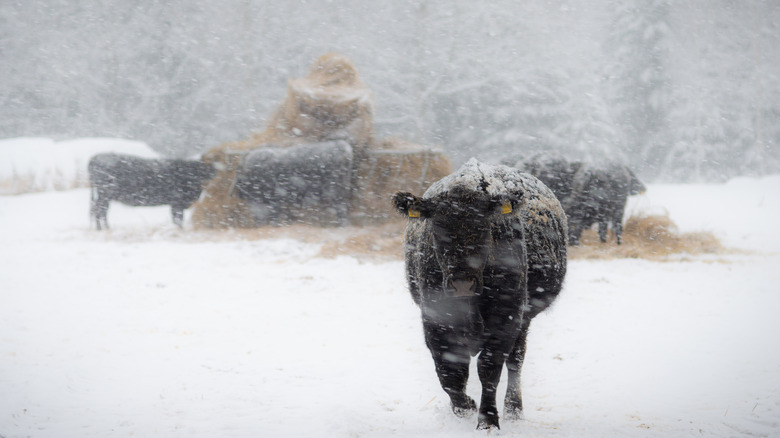The Most Eye-Opening Stories From The Schoolhouse Blizzard Of 1888
We live in an age of information overload, and that goes for meteorological information, too. Not sure whether to put on that extra layer of clothing or bring a neck scarf and gloves? Flip on the TV, and the Weather Channel will give you the full scoop on the hours ahead and how to prepare. No crazy weather flies under the radar in today's world.
Countless apps also predict temperature, barometric pressure, fronts, tornadoes, hurricanes, snowstorms, and anything else that might derail your day. Thanks to technology, you have the equivalent of unlimited access to a virtual, portable weather person. Predicting weather isn't without its flaws, of course (via Scientific American), but it's still much better than what people dealt with in the 19th century. Back then, extreme weather often came with little to no warning. As a result, devastating consequences sometimes followed.
Take, for example, the so-called "Children's Blizzard" of January, 12, 1888, which hit the Dakota Territory at the worst time possible: the end of the school day (via the MinnPost). This meant thousands of individuals, many of them kids, were caught outside when the storm's full force exploded, leaving an estimated 250 to 500 dead. Keep reading for the most eye-opening stories from the event and what it was like to live through it.
An unseasonably warm morning preceded the blizzard
According to Scientific American, there's often a lull before extreme weather hits. This may take different forms: the eye of the hurricane, the calm before tornados touch down, or warm and sunny weather prior to a life-threatening blizzard. In the case of the Schoolhouse Blizzard of 1888, beautiful weather left locals unprepared for the Arctic front to come, per the MinnPost.
It was the kind of weather that tempted winter-weary Midwestern settlers out of their homes. According to Carl Saltee, 16, of Fortier, Minnesota, the unseasonably warm temperatures melted snow and ice. Morton Basset of Nobles County recorded, "It was a beautiful day for mid-winter, and no one even thought of what a change an hour's time could bring." Kids headed to one-room schoolhouses without coats, scarves, hats, or gloves. Farmers worked their fields coatless (via History Nebraska), while others traveled to nearby towns to fortify their winter pantries or visit loved ones.
Residents had no clue a devastating cold front steamrolled towards them from Canada, traveling nearly 800 miles in under 20 hours! (For an inexplicable reason, the Army Signal Corps sat on a "Cold Wave" advisory the night before the storm, leaving locals clueless.) Modern-day Nebraska and South Dakota took the brunt of the devastation. But it also impacted a larger swathe of land from Colorado to Kansas, Minnesota to Wisconsin, per the Wichita Eagle. Without satellite imagery, climate data, and weather apps, settlers never knew what hit them.
The blizzard came with almost no warning
Ask the experts, and they'll tell you the Blizzard of 1888 wasn't the worst storm to ever hit the Midwest, per the MinnPost. But what the cold front lacked in extremes, it made up for in tragic timing. It's no exaggeration to say the weather went from pleasant to lethal in minutes. By the time many realized they were on a collision course with disaster, it was already too late.
Eyewitnesses described the front as containing hurricane-like gusts. But instead of delivering warm rains and tropical temperatures, it brought Arctic freeze and sheets of frost. Almost instantly, conditions went from temperate to frigid as blinding ice assaulted anyone caught outdoors. Temperatures dropped by double digits. In some spots, History says historical records indicate a plunge of 100 degrees Fahrenheit over the course of 24 hours!
The only warning came in the form of an ominous "soot gray cloud" and a weird momentary calm (via David Laskin's "The Children's Blizzard"). Too soon, deafening blasts of Arctic air pierced the unsettling tranquility. Endless stretches of golden prairie transformed into blinding walls of white. The relentless wind continued as "every crevice, every gap and orifice instantly filled with shattered crystals, blinding, smothering, suffocating, burying everything exposed to [it]." Those fooled by Jack Frost's momentary respite were in for a lesson they'd never forget. But first, they had to survive.
Zero visibility took on a new meaning
Extreme conditions smashed into the Midwest like a freight train, bringing instant subzero temperatures and zero visibility, per History. And we're not talking about the kind of visibility that comes with puffy, sparkling snowflakes floating en masse through the sky. Instead, the cold blast from Canada drove micro-ice into everything, from clothes to peoples' eyes.
It sealed eyelids shut, making it impossible to navigate to safety, even where hearths lay a mere hundred feet (or less) away. But the fine glass-like shards that filled the air did more than wreak havoc on eyes. They filled lungs, suffocating people and animals where they stood. And even clothes proved inadequate shields against the onslaught. According to "The Children's Blizzard," "It sifted into the loose weave of their coats, shirts, dresses, and underwear until their skin was packed in snow."
Frozen particles and drastic temperature drops sent body cores to fatal lows, contributing to disorientation and panic as people attempted to fight their way to shelter. Excruciating physical effects also took hold, including hypothermia and frostbite (via Live Science). At subzero temperatures, the body begins shutting down in mere minutes, leading to amnesia, loss of consciousness, and death. Experts estimate that the blizzard brought temperatures of 40 below zero or less to the Dakotas, triggering medical precursors of death within five to seven minutes.
The blizzard's wind was nightmarish
Trying to wrap your head around the ground conditions during the blizzard of 1888 isn't easy. After all, it was a unique experience most people will, thankfully, never have to endure. But historical accounts provide graphic descriptions of the life-and-death battle settlers faced. Writing about the experience to loved ones, T.C. Porter observed, "I suppose you have read all about the recent storm we have had in the west, but you can't realize how they are unless you should witness one" (via History Nebraska). Porter likened the event to the sky falling.
As for Porter's wife and children, they suffered through the blizzard alone because the fine weather had motivated him to deliver a load of corn to town, where he remained due to the storm. The first indication something was wrong came in the afternoon when Porter noted her cats swirled in circles on the doorstep as if inebriated. Dark clouds and bracing wind followed, tormenting the family all night.
At one point, Porter bundled up to head outside for more corn cobs to burn as fuel. On the way back, she got knocked to the ground by the wind. Disoriented, she crawled back to the house, barely reaching it alive. Meanwhile, the entire house groaned and shuddered around the family. It sounded like it might come crashing down on their heads. She noted later that the plaster on the second floor had cracked because of the powerful gusts.
Some people mistook the blizzard for a train
The tremendous power associated with the blizzard confused some individuals. According to "The Children's Blizzard," even the sounds produced by the storm proved confounding. As a result, precious minutes of warning time got lost in bewilderment. The blizzard caught Austin and Karen Rollag out doing farm chores.
Out of nowhere, they heard a tremendous growling noise. It was approximately 3:30 p.m., and they didn't know what to make of it. Austin Rollag later recounted, "At first, we thought that it was the Omaha train which had been blocked and was trying to open the track." What came next left little doubt in their minds. Snow slammed down onto the couple. The sky darkened nearly to pitch, and temperatures nosedived.
The couple sprang into action, securing their animals before heading inside. A foal gave them some extra trouble, but they managed to get the little guy inside before escaping to the warmth of the house themselves. While risking their lives for livestock might sound strange, this was a knee-jerk reaction made by many of the blizzard survivors (and victims). Animals represented the future of a farm, and they weren't about to see their assets freeze, if they could help it. The Rollags didn't understand how lucky they were to make it safely indoors where their children remained secure with a grandparent. Far too many families, especially those with school-aged kids, wouldn't enjoy this happy fate.
Survival strategies took various forms
Panicking meant death, something Ole Rollag recognized, per "The Children's Blizzard." After the storm hit, Grace Rollag, Ole's wife, searched the horizon, keeping vigil for her husband as hope dissolved. The clock ticked, and her fears intensified. Yet, the impossible occurred when he eventually emerged from the storm's white wall. Later, she reflected, "It was a miracle that Ole had found the way. But he never lost his composure so that the whole time he knew which direction to take."
Frank Carney worked as the night telegraph operator for the Chicago and Northwestern Railway, stationed in a train car near Omaha, Nebraska, when the punishing winds arrived (via History Nebraska). By 9 p.m., the storm had grown to such a fevered pitch Carney was sure the entire car would get picked up by the wind. After obtaining leave, he relied on freshly laid railroad tracks outside to feel his way the half mile back to the depot, where he sheltered overnight.
Getting beneath the storm also proved helpful for survival (via David Laskin). Will Allen searched frantically for his missing 8-year-old brother, Walter, by crawling on all fours. Somehow, he figured out that dropping to the ground improved visibility. Remarkably, he found his brother unconscious but alive in a field, and both survived. Arthur E. Towne's father knew from living in Vermont that eyes aren't helpful during blizzards. Instead, he crawled home, feeling wagon wheel ruts to reach his doorstep.
There was no hope for some lost in the storm
Many incredible survival stories emerged from the blizzard of 1888. But these accounts were by no means the norm, as reported in "The Children's Blizzard." Because of the nature of the storm and its rapid onset, countless individuals perished, unable to find shelter in the few minutes available to them before the profound effects of hypothermia and frostbite set in.
One of these victims was Norwegian immigrant Ole Tisland, who lived in Brookings County in the Dakota Territory. Tisland migrated to the U.S. after the Civil War. Unfortunately, he proved ill-prepared for what life in the Midwest would bring. He stood outside shoveling on the family homestead when the storm approached. His wife, Karen Tisland, remembered her final vision of him — staring into the darkened horizon, unmoving. She never understood why he didn't drop the shovel to sprint home.
By nightfall, Tisland's cheeks lay bare to the bone where he'd inadvertently torn away the frozen flesh, trying to keep the snow and ice out of his eyes. A child in a neighboring farmhouse, Carl Hildens, heard distant yet persistent screams. On repeated urgings from the boy, his dad went outside to investigate but found no one. Whether the cries came from Tisland, the Hildens never knew. But the next day revealed the Norwegian father and grandfather had died alone on the frigid prairie.
Some schoolteachers attempted to save their students
The brunt of the fatalities came from schoolchildren making their way home, per the Nebraska State Historical Society. Among the most tragic accounts came from Johann Kaufmann, who found his three children frozen together after the storm (via Bill Streever's "Cold"). He had to transport their bodies as one mass, thawing them at the family cabin before individual burial.
Some teachers refused to dismiss their classes, realizing the ominous sky held potential danger. But even this strategy came with mixed results. According to History Nebraska, Lois Royce of Plainview, Nebraska, kept three young pupils with her. But her poorly constructed schoolhouse didn't provide enough shelter or fuel to last the storm. Royce's boarding house lay a tantalizing 90 yards away, so the teacher and students ran for it. Sadly, they became lost, and the children died. Royce survived the ordeal but had to have her feet amputated due to extreme frostbite.
Fortunately, other teachers enjoyed greater success. In Pawnee City, Nebraska, Seymour Dopp kept 17 pupils on lockdown overnight, burning stockpiled wood to stay warm (via History). And Minnie Freeman of Mina Valley, Nebraska, successfully led 13 students to safety (some say tied together with twine) after the blizzard's wind tore the roof off her one-room schoolhouse, per the University of Nebraska, Kearney. Freeman became the press's darling, and the song "Thirteen Were Saved, or Nebraska's Fearless Maid," commemorated her heroism.
People died just steps from their homes
Stories of children dying on the open plains proved immensely tragic. So did tales of people who perished steps away from safety, per the MinnPost. These accounts underscored the devastating irony of the blizzard, which saw many die on the veritable threshold to safety. The wide-open nature of the prairie, with few landmarks or markers of any sort, exacerbated the confusion of the storm as people attempted to navigate the frozen landscape.
After her husband, Knut Knutson, didn't return from Rushmore, Minnesota, where he'd traveled for extra supplies, Seselia Knutson, a Norwegian immigrant, felt increasingly anxious. Fearing he'd been caught alone on the plains by the storm, she decided to go looking for him. Had Seselia Knutson grown up in the region, perhaps she would've known to take extra precautions, like tying a rope around her waist so that she could get back to her starting point. But she never stood a chance. Tragically, Seselia Knutson died 40 steps from her front door, having attempted to shelter under a sled. She wasn't alone.
Like Knut Knutson, Hanley Countryman headed out on the morning of January 12 to take full advantage of the balmy weather. He fortified his supply stores, securing 40 pounds of provisions to carry home. When the storm hit, Countryman was likely already tired from hiking with the heavy load. He attempted to go on, probably becoming disoriented. Finally, he laid down to die a mere 150 yards from his doorstep.
Many survived the night only to die later
Surviving the blizzard didn't come with any guarantees (via "The Children's Blizzard"). Many people managed to get through the whole night only to die due to the after-effects of the freezing weather. For example, Omar Gibson spent the night sheltered beneath a horse blanket with his step-niece, Amelia Shirk. But as Shirk later attested, after getting up and moving around, Gibson dropped dead from shock. The same happened to Jesse Beadel when he went for help the morning after the storm, a phenomenon known in the medical profession as rewarming shock.
Ultimately, rewarming shock refers to cardiac arrest following rescue from extreme cold. What Gibson and Beadel didn't realize is that their hearts were intensely fragile. The slightest disturbance — standing up and moving — pushed them over the edge as frigid blood from their outer extremities made its way to their hearts. The sudden circulation resulted in instant and fatal atrial fibrillation.
Etta Shattuck, a schoolteacher from Holt County, Nebraska, survived the blizzard by seeking shelter in a haystack (via "The Children's Blizzard"). But the haystack became an icy prison, trapping her for days. When rescuers finally discovered her, frostbite had severely damaged her feet and legs. Although she survived for weeks, undergoing amputation of her gangrenous members, she eventually passed away, either from an infection or pneumonia.
The blizzard came with devastating after-effects
One of the most gruesome stories to come out of the Children's Blizzard involved a herd of cattle, as reported by "The Children's Blizzard." While the human death toll from the storm rightly gets most of the attention, the impact on animals proved horrific, too. What happened to James Jackson, a Scotsman living in Pipestone County, Minnesota, best illustrates this point.
After his herd of Black Angus cattle disappeared in the snowy deluge, he went searching for them. Livestock represented a settler's livelihood and survival, which meant going to extraordinary lengths to protect them. Jackson rode for miles before locating the herd. Jackson's cows stood frozen stiff in a 10-mile-long line of beef popsicles. Amid this frightening scene, Jackson sometimes came across a living cow, which he covered with snow to try and prevent further freezing. Unfortunately, the strategy backfired.
As the cows warmed, they struggled to their feet. Re-exposed to the intense and frigid wind, they froze as thoroughly as their counterparts along the 10-mile-long line. Remarkably, Jackson still managed to get a handful of live cattle back to his barn. But according to an account by his neighbor, David Maxwell Fyffe, "When they got properly thawed out, the frozen flesh came off them in chunks ... Jackson was left with only two bulls which were kept around the barns." The nightmarish scene underscored the devastating consequences of the deadliest blizzard in Midwestern history for animals and humans alike (via the MinnPost).
